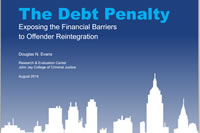 In a new paper released in August, Douglas N. Evans of John Jay College of Criminal Justice’s Research & Evaluation Center discusses the seemingly endless cycle of crime, fees and debt associated with our current penal system. Across the country, convicts are required to pay varying sums of money to courts and victims in the form of court fees, installment fees, late fees, and restitution, which can become a large burden for offenders who have poor chances of finding employment upon release.
In a new paper released in August, Douglas N. Evans of John Jay College of Criminal Justice’s Research & Evaluation Center discusses the seemingly endless cycle of crime, fees and debt associated with our current penal system. Across the country, convicts are required to pay varying sums of money to courts and victims in the form of court fees, installment fees, late fees, and restitution, which can become a large burden for offenders who have poor chances of finding employment upon release.
In some states, parole and probation may be revoked if an offender is unable to pay his or her court fees, often leading to high recidivism rates. On the contrary, in cases where restitution to victims is mandated, recidivism rates tend to be lower, especially if the offender is able to make payments to the court. Across the country, court systems are using both of these methods and everything in between, producing both positive and negative results.
What is the best way to incorporate debt and corrections? Read the full report![]()
